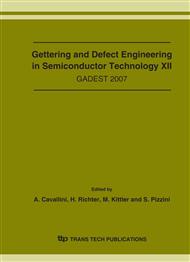p.247
p.253
p.259
p.265
p.271
p.277
p.283
p.289
p.293
Effect of Hydrostatic Pressure on Self-Interstitial Diffusion in Si, Ge, Si<Ge> Crystals: Quantum-Chemical Simulations
Abstract:
A theoretical modeling of the diffusion of self-interstitials in silicon and germanium crystals both at normal and high hydrostatic pressure has been carried out using molecular mechanics, semiempirical (PM3, PM5) and ab-initio (SIESTA) methods. According to the simulation for the Si and Ge neutral interstitials (I0) both in silicon and germanium crystals more stable configuration is <110> split interstitial. T is the stable configuration for the double positive interstitial I++, but the interstitial is displaced from the high-symmetry site. Stability of <110> splitinterstitial is not changed under hydrostatic pressure. The activation barriers for the diffusion of interstitials were determined and equal to ΔEa(Si)(<110> -> T1)=0.69 eV; ΔEa (Ge)(<110> -> T1)=1.1 eV. For mixed interstitials the calculated activation barriers equal Si Emix = 1.06 eV, Ge Emix = 0.86 eV. Hydrostatic pressure decreases the activation barriers ΔEa(Si), ΔEa (Ge).
Info:
Periodical:
Pages:
271-276
Citation:
Online since:
October 2007
Authors:
Keywords:
Price:
Сopyright:
© 2008 Trans Tech Publications Ltd. All Rights Reserved
Share:
Citation:


